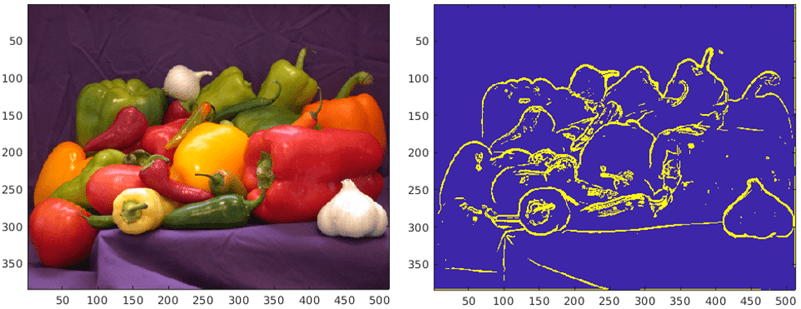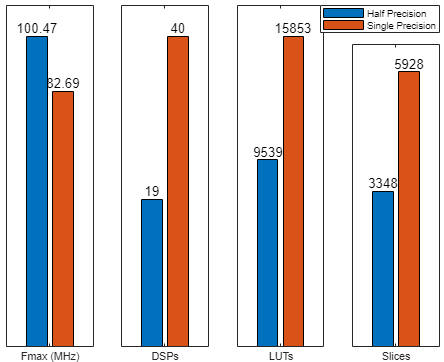What Is Half Precision?
The IEEE® 754 half-precision floating-point format is a 16-bit word divided into a 1-bit sign indicator s, a 5-bit biased exponent e, and a 10-bit fraction f.

Because numbers of type half are stored using 16 bits, they require less memory than numbers of type single, which uses 32 bits, or double, which uses 64 bits. However, because they are stored with fewer bits, numbers of type half are represented to less precision than numbers of type single or double.
The range, bias, and precision for supported floating-point data types are given in the table below.
Data Type | Low Limit | High Limit | Exponent Bias | Precision |
|---|---|---|---|---|
| Half | 2−14 ≈ 6.1·10−5 | (2−2-10) ·215≈ 6.5·104 | 15 | 2−10 ≈ 10−3 |
Single | 2−126 ≈ 10−38 | 2128 ≈ 3 · 1038 | 127 | 2−23 ≈ 10−7 |
Double | 2−1022 ≈ 2 · 10−308 | 21024 ≈ 2 · 10308 | 1023 | 2−52 ≈ 10−16 |
For a video introduction to the half-precision data type, see What Is Half Precision? and Half-Precision Math in Modeling and Code Generation.
Half Precision Applications
When an algorithm contains large or unknown dynamic ranges (for example integrators in
feedback loops) or when the algorithm uses operations that are difficult to design in
fixed-point (for example atan2), it can be advantageous to use
floating-point representations. The half-precision data type occupies only 16 bits of
memory, but its floating-point representation enables it to handle wider dynamic ranges
than integer or fixed-point data types of the same size. This makes half precision
particularly suitable for some image processing and graphics applications. When
half-precision is used with deep neural networks, the time
needed for training and inference can be reduced. By
using half precision as a storage time for lookup tables, the memory footprint of the
lookup table can be reduced.
MATLAB Examples
Fog Rectification — The fog rectification image processing algorithm uses convolution, image color space conversion, and histogram-based contrast stretching to enhance the input image. This example shows how to generate and execute CUDA® MEX with half-precision data types for these image processing operations.

Edge Detection with Sobel Method in Half-Precision — The Sobel edge detection algorithm takes an input image and returns an output image that emphasizes high spatial frequency regions that correspond to edges in the input image. This example shows how to generate and execute CUDA MEX with the half-precision data type used for the input image and Sobel operator kernel values.

Generate Code for Sobel Edge Detection That Uses Half-Precision Data Type — This example shows how to generate a standalone C++ library from a MATLAB® function that performs Sobel edge detection of images by using half-precision floating point numbers.
Simulink Examples
Half-Precision Field-Oriented Control Algorithm (Fixed-Point Designer) — This example implements a Field-Oriented Control (FOC) algorithm using both single precision and half precision.
Image Quantization with Half-Precision Data Types (Fixed-Point Designer) — This example shows the effects of quantization on images. While the fixed-point data type does not always produce an acceptable results, the half-precision data type, which uses the same number of bits as the fixed-point data type, produces a result comparable to the single-precision result.

Digit Classification with Half-Precision Data Types (Fixed-Point Designer) — This example compares the results of a trained neural network classification model in double precision and half precision.
Convert Single Precision Lookup Table to Half Precision (Fixed-Point Designer) — This example demonstrates how to convert a single-precision lookup table to use half precision. Half precision is the storage type; the lookup table computations are performed using single precision. After converting to half precision, the memory size of the Lookup Table blocks are reduced by half while maintaining the desired system performance.
Benefits of Using Half Precision in Embedded Applications
The half precision data type uses less memory than other floating-point types like single and double. Though it occupies only 16 bits of memory, its floating-point representations enables it to handle wider dynamic ranges than integer or fixed-point data types of the same size.
FPGA
The half precision data type uses significantly less area and has low latency compared to the single precision data type when used on hardware. Half precision is particularly advantageous for low dynamic range applications.
The following plot shows the advantage of using half precision for an implementation of a field-oriented control algorithm in Xilinx® Virtex® 7 hardware.

GPU
In GPUs that support the half-precision data type, arithmetic operations are faster as compared to single or double precision.
In applications like deep learning, which require a large number of computations, using half precision can provide significant performance benefits without significant loss of precision. With GPU Coder™, you can generate optimized code for prediction of a variety of trained deep learning networks from the Deep Learning Toolbox™. You can configure the code generator to take advantage of the NVIDIA® TensorRT high performance inference library for NVIDIA GPUs. TensorRT provides improved latency, throughput, and memory efficiency by combining network layers and optimizing kernel selection. You can also configure the code generator to take advantage TensorRT's precision modes (FP32, FP16, or INT8) to further improve performance and reduce memory requirements.
CPU
In CPUs that support the half-precision data type, arithmetic operations are faster as compared to single or double precision. For ARM® targets that natively support half-precision data types, you can generate native half C code from MATLAB or Simulink®. See Code Generation with Half Precision (Fixed-Point Designer).
Half Precision in MATLAB
Many functions in MATLAB support the half-precision data type. For a full list of supported functions, see half (Fixed-Point Designer).
Half Precision in Simulink
Signals and block outputs in Simulink can specify a half-precision data type. The half-precision data type is supported for simulation and code generation for parameters and a subset of blocks. To view the blocks that support half precision, at the command line, type:
showblockdatatypetable
Blocks that support half precision display an X in the column labeled Half. For detailed information about half precision support in Simulink, see The Half-Precision Data Type in Simulink (Fixed-Point Designer).
Code Generation with Half Precision
The half precision data type is supported for C/C++ code generation, CUDA code generation using GPU Coder, and HDL code generation using HDL Coder™. For GPU targets, the half-precision data type uses the native half data type available in NVIDIA GPU for maximum performance.
For detailed code generation support for half precision in MATLAB and Simulink, see Half Precision Code Generation Support (Fixed-Point Designer) and The Half-Precision Data Type in Simulink (Fixed-Point Designer).
For embedded hardware targets that natively support special types for half precision, such as _Float16 and _fp16 data types for ARM compilers, you can generate native half precision C code using Embedded Coder® or MATLAB
Coder™. For more information, see Generate Native Half-Precision C Code from Simulink Models (Fixed-Point Designer) and Generate Native Half-Precision C Code Using MATLAB Coder (Fixed-Point Designer).
See Also
half (Fixed-Point Designer) | The Half-Precision Data Type in Simulink (Fixed-Point Designer) | "Half Precision" 16-bit Floating Point Arithmetic | Floating-Point Numbers (Fixed-Point Designer)
Topics
- Fog Rectification
- Edge Detection with Sobel Method in Half-Precision
- Generate Code for Sobel Edge Detection That Uses Half-Precision Data Type
- Half-Precision Field-Oriented Control Algorithm (Fixed-Point Designer)
- Image Quantization with Half-Precision Data Types (Fixed-Point Designer)
- Digit Classification with Half-Precision Data Types (Fixed-Point Designer)
- Convert Single Precision Lookup Table to Half Precision (Fixed-Point Designer)